Chairwoman Norton, Ranking Member Davis and members of the Subcommittee, thank you for inviting me to testify today on improving the safety of our nation’s roadways.
It is an honor to be with you today. My name is Nicholas Smith, and I am the Interim President and CEO of the National Safety Council (NSC) and the Chair of the Road to Zero Coalition. It is nice to be back in Washington, as I previously lived and worked here at the Department of Homeland Security and for Majority Leader Bill Frist.
The National Safety Council is a 100-year-old nonprofit committed to eliminating preventable deaths in our lifetime by focusing on reducing fatalities and injuries in workplaces, on the road and in homes and communities. Our more than 15,000 member companies represent employees at more than 50,000 U.S. worksites. Not only do we work with companies but also with organized labor, who share our dedication to keeping workers safe on and off the job. These members are across the United States and are likely in each district represented on this Committee.
The National Safety Council estimates that over 40,000 people were killed in motor vehicle crashes in 2018. Included here are the number of people killed in motor vehicle crashes in 2018 from the Chairs’ and Ranking Members’ states, and a complete overview of all states is included with my testimony.
| District of Columbia | 34 |
| Illinois | 1,048 |
| Missouri | 917 |
| Oregon | 468 |
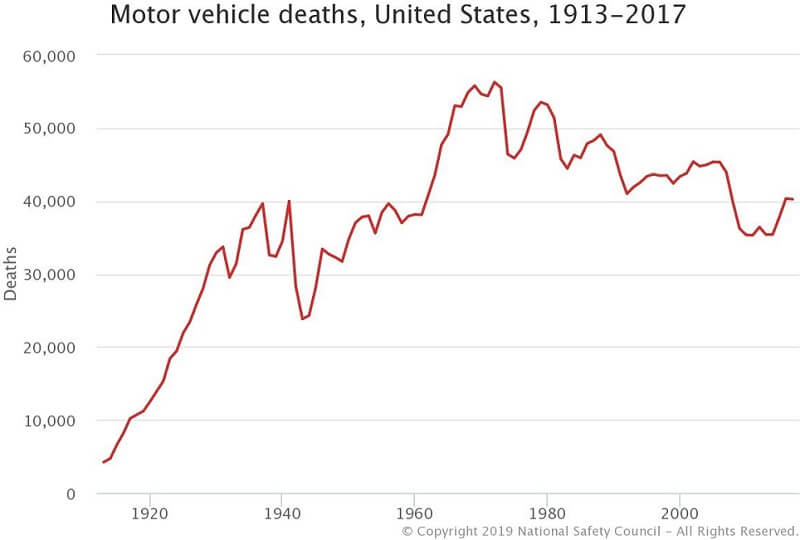
These are the lives of your constituents. These mothers, fathers, sisters, brothers, aunts and uncles contributed to the communities in which they lived. Yet, our national outrage at these losses is conspicuously absent, particularly when you compare to deaths in other forms of transportation, such as aviation. These crashes and deaths on our roadways not only have a human toll, but there is an annual cost to the American economy of over $433 billion.
The United States has consistently avoided the hard choices needed to save lives on the roadways. The reauthorization of the Fixing America’s Surface Transportation (FAST) Act is an opportunity for us to start making the right choices, and I appreciate the opportunity to talk with you today about how to do more to save lives, because we know that all of these deaths are preventable.
What disappoints many of us in the safety community is that the main causes of motor vehicle fatalities – lack of seat belt use, alcohol-impaired driving, and speed – have remained the same for decades.
- 50% of people who die in motor vehicle crashes are unbelted
- 30% of people who die in crashes are involved in alcohol-impaired wrecks
- 27% of the fatalities are speed-related
The solutions to these problems are simple and clearly known, but we need the political and societal will to widely implement them.
Recently, “zero” language has been incorporated into the goals on our roadways. This has been commonplace in other settings like workplaces, where NSC has been involved since its beginning, and it has had meaningful results. NSC is so committed to a zero goal on the roadways that we lead the Road to Zero Coalition, a diverse group of over 900 members committed to eliminating roadway fatalities by 2050. Over the past two and a half years, the coalition has grown to include members from across the country representing transportation organizations, businesses, academia, safety advocates and others, the first time so many organizations have collaborated to put forth a plan to address fatalities on our roads.
The centerpiece of our work together has been the creation of the Road to Zero report, a comprehensive roadmap of the strategies necessary to achieve our goal by 2050. One year ago this month, the coalition issued our report with three primary recommendations.
- Double down on what works through proven, evidence-based strategies
- Accelerate advanced life-saving technology in vehicles and infrastructure
- Prioritize safety by adopting a safe systems approach and creating a positive safety culture
Double Down
We know what works. Enacting evidence-based laws related to seatbelts, alcohol impairment and speed shows we are ready for change, and education about the laws combined with strong enforcement delivers on the change. We urge legislators to look at these and the many other laws that, if enacted, enforced and promoted would drive down fatalities. While many of these laws require state action, the federal government should consider incentives in the reauthorization bill to accelerate state adoption and enforcement.
The data and research tell us that primary seat belt laws, lowered blood alcohol content laws, and better speed management efforts would have meaningful impact.
Seatbelts
Regardless of other causal factors, the lack of proper occupant restraint continues to increase the severity and lethality of motor vehicle crashes. While 89.6% of American drivers and vehicle occupants used seat belts in 2018, more than 1 in 10 continued to put their lives at unnecessary risk, with tragic consequences. Almost half (47%) of people killed in motor vehicle crashes in 2017 were unbelted. Yet despite these data, only 34 states and the District of Columbia have primary enforcement of their seatbelt laws – meaning law enforcement may stop vehicles solely for belt law violations. Of the other 16 states, 15 have secondary laws – requiring police to have another reason for a traffic stop – and one, New Hampshire, has no belt law.
Primary seatbelt laws are proven to increase the rate of belt use and save lives. In 2018, 90.6% of passenger vehicle occupants were belted in states with primary laws, while only 86.4% of occupants were belted in states with secondary or no seatbelt laws. There should only be one acceptable level of safety. Public education and high-visibility enforcement campaigns such as Click It or Ticket have increased public awareness of the dangers of driving unrestrained, but will only be most effective when accompanied by strong laws.
In 2016, the National Highway Traffic Safety Administration (NHTSA) estimates that the use of seat belts in passenger vehicles saved 14,668 lives and if all drivers and passengers had worn their seatbelts, an additional 2,456 lives would have been saved. In Oregon and Illinois, 16 and 52 lives respectively could have been saved with 100% seat belt use. Similarly, the Center for Disease Control and Prevention provides the Motor Vehicle Prioritizing Interventions and Cost Calculator for States (MV PICCS) to help policymakers determine the lives saved and costs of implementation of 14 different evidence-based motor vehicle laws. When comparing Oregon and Illinois again, seat belt enforcement campaigns could save 16 and 35 lives respectively.
Impairment
Another leading cause of roadway deaths is alcohol impairment. Every day, almost 30 people die in alcohol-impaired crashes in the United States – one every 48 minutes. Despite these data, our culture does not prioritize safety, with more than 1 in 10 drivers admitting to driving in the prior year when they thought they were close to or over the legal blood alcohol content (BAC) limit.
The data are clear: drivers are four times more likely to crash at .05 than if they had nothing to drink. Most other industrialized countries have implemented a BAC of .05 or lower, changes which have been followed by decreasing numbers of fatalities from alcohol-impaired crashes. Lowering the BAC limit from .08 to .05 is proven to save lives on the roadways, and in the U.S. could save as many as 1,500 lives if implemented nationally. Utah is the first state in the U.S. to pass a law lowering the BAC to .05. NSC supports other states attempting to implement such legislation, and hopes to see federal legislation introduced to this end.
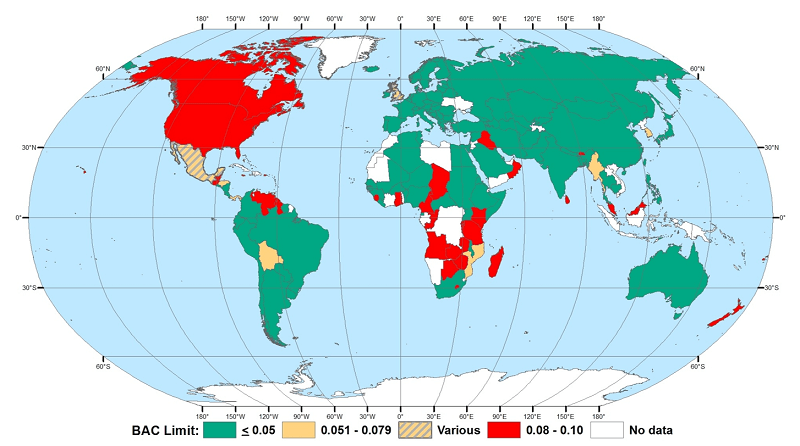 Source: National Transportation Safety Board Safety Report on Eliminating Impaired Driving (2013)
Source: National Transportation Safety Board Safety Report on Eliminating Impaired Driving (2013)
Speed
The United States has a fatal problem with driving too fast. Just last week, the Insurance Institute for Highway Safety (IIHS) estimated that increasing speed limits over the past 25 years have led to 37,000 deaths. Nearly 27% of roadway fatalities include speed as a causal factor, a factor that is even more deadly for our growing population of vulnerable road users such as pedestrians and bicyclists.
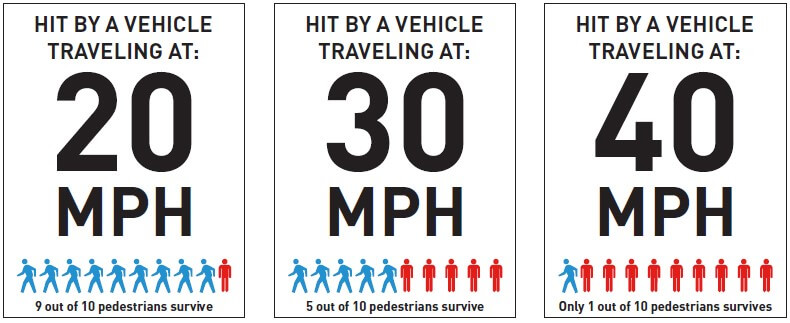 Image: Seattle Department of Transportation
Image: Seattle Department of Transportation
As illustrated, at 20 miles per hour, 9 out of 10 pedestrians would survive being struck by a vehicle, but if you double that speed, 9 out of 10 pedestrians would be killed.
It is not only pedestrians and other vulnerable road users impacted by excess speed, but also 9,242 motor vehicle drivers and occupants who died in 2017 in speed-related crashes. One evidence-based proven countermeasure for speed is automated enforcement. Automated enforcement is proven to reduce speed and save lives, but implementation must be done properly, with safety – not revenue – as the primary objective. NSC, AAA, the Advocates for Highway and Auto Safety and IIHS created the attached checklist to provide guidance to communities as they deploy automated enforcement. As you can see, the guidance encourages transparency and grace among enforcement actions given and dedication of the funds to safety, trauma care or similar purpose.
There are other deadly problems on our roadways, like distraction, that we can do more to solve as well, and these issues should not be overlooked by this Committee.
Advance Technology
Technology is an important disrupter that will continue to transform roadway safety well into the foreseeable future. To reach zero deaths, we need to encourage the development of innovations that address human failures and road design failures and, once proven, establish mandates for adoption of technologies that work. Further, this regulatory certainty and defined standards should drive interoperability and ensure meaningful outcomes. Additionally, data collection on serious and fatal crashes should be required in order to share consistent and verified information, and testing on public roads should be reported to the jurisdictions in which the tests occur. This level of transparency will help consumers better understand the technology and how to operate in it, with it and around it.
Establishing performance standards and common nomenclature for the automated vehicle (AV) technology will also help encourage better understanding. Earlier this year, AAA released a report about the lack of consistency. In it, they found adaptive cruise control has 20 different names and lane keeping assistance has 19 unique names. The trend continued with other technologies. These different names do not aid consumer understanding and acceptance. In fact, AAA also found that over 70% of consumers are afraid of fully automated vehicles. This reauthorization bill should help establish more standards for technology by building the necessary frameworks to support our desired outcomes to reduce deaths on the roadways, and it should include commercial motor vehicles too.
As we sit here today, automakers, technology firms and others are developing partially and fully automated vehicles. The potential safety benefits of automated vehicles could be incredible. When ready, these vehicles will not glance down at their phone, speed through a red light or have an alcoholic beverage before getting behind the wheel – all mistakes that we as human drivers continue to make over and over again, with deadly consequences. To be clear, it will be decades before we have meaningful fleet penetration on U.S. roadways of AVs. In the meantime, there are significant technologies available in vehicles today, Advanced Driver Assistance Systems (ADAS) that can prevent or mitigate crashes. Consumer education about these technologies is key.
While standards are essential, public education is also important. The National Safety Council is working to expand consumer education around these new technologies. NSC and the University of Iowa created a website, MyCarDoesWhat.org, to help. When a person visits MyCarDoesWhat.org, he or she learns about dozens of existing safety features such as lane departure warning, blind spot monitoring, backup cameras, automatic emergency braking and more. The MyCarDoesWhat team has developed videos, infographics and other informational pieces to help drivers understand how these technologies work and what they are capable of doing. The purpose of MyCarDoesWhat is to educate the public about these assistive safety features in order to maximize their potential lifesaving benefits.
Additionally, the National Safety Council was a founding member of PAVE (Partners for Automated Vehicle Education), which launched in January. PAVE is a broad-based coalition that includes automotive and technology companies, safety and mobility advocates and community partners. PAVE members believe that in order to fully realize the benefits of self-driving technology, policymakers and the public need factual information about the present and future state of such technology. PAVE enhances public understanding through a variety of strategies including an educational website at PaveCampaign.org; “hands-on” demonstrations allowing the public to see and experience driverless technology; and workshops to help policymakers understand the technology. In the future, PAVE will produce educational toolkits for car dealers to help them communicate more effectively with customers about their vehicles’ capabilities and limitations.
When it comes to technology, the U.S. prioritized safety years ago by dedicating spectrum for safety purposes to prevent crashes. Today, other groups would like to take the spectrum for streaming services. I urge this committee to direct the U.S. DOT, the Federal Communications Commission, the Department of Commerce and others to maintain the spectrum for roadway safety purposes allowing vehicles to communicate with each other, infrastructure, pedestrians and others to prevent crashes. This spectrum provides a safety margin that we should not give away.
Prioritize Safety
By prioritizing safety, we commit to changing our nation’s safety culture. This means we have to accept that any life lost is one too many. Once we accept that one death is too many, we will begin thinking about how to take a “safe systems” approach to our roadways. Fully adopted by the aviation industry, this means building fail-safe features that anticipate human error and developing infrastructure with safety margins.
With the understanding that people will make mistakes, the built environment or infrastructure can be more forgiving to eliminate fatalities. Some of these changes may include engineering greater safety into a design. For example, in the pictures below, a multi-lane intersection with a red light in Scottsdale, Arizona was replaced with a roundabout. With the intersection, there are 32 potential points of failure, but with a roundabout, that is engineered down to only 8. Speeds are decreased, and if crashes do occur, they occur at angles that are not as violent.
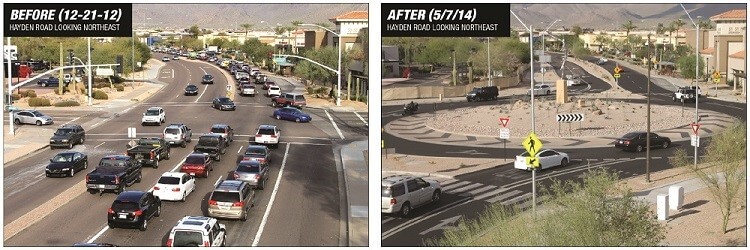
Successful infrastructure redesign can also look like the picture below from New York City. The picture on the left shows two roads merging together without an area for pedestrians, and the lane lines are non-existent. However, the reworked merge incorporates clearly marked lanes of travel, large sidewalks and areas of less exposure to vehicles for pedestrians.
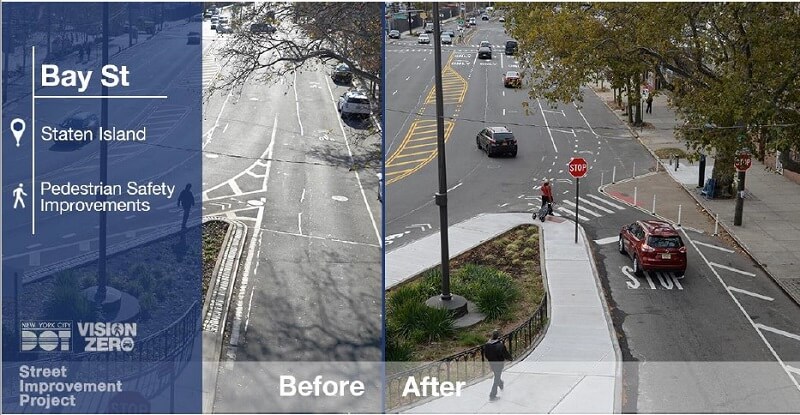
These infrastructure changes are just as important in rural areas. Rumble strips on the center line or edge of roadways can prevent the roadway departure crashes that account for 52% of fatalities in the U.S. Cable median barriers can also provide a margin of safety to redirect people in to their lane of travel, and high friction surface treatments can decrease vehicle stopping distance on roadways. These are all tools we have available today.
Infrastructure changes can be expensive, but they do not have to be. Through the Road to Zero Coalition, NSC has awarded grants to groups across the country working in communities of all sizes. In the first year of grants, the National Complete Streets Coalition, which is testifying today too, worked with three communities: Lexington, KY, Orlando, FL, and South Bend, IN. Each city was provided only $8,000 dollars from the grant for temporary infrastructure changes that you can see below to measure results. Each city had measurable improvements to safety even with a small dollar investment.
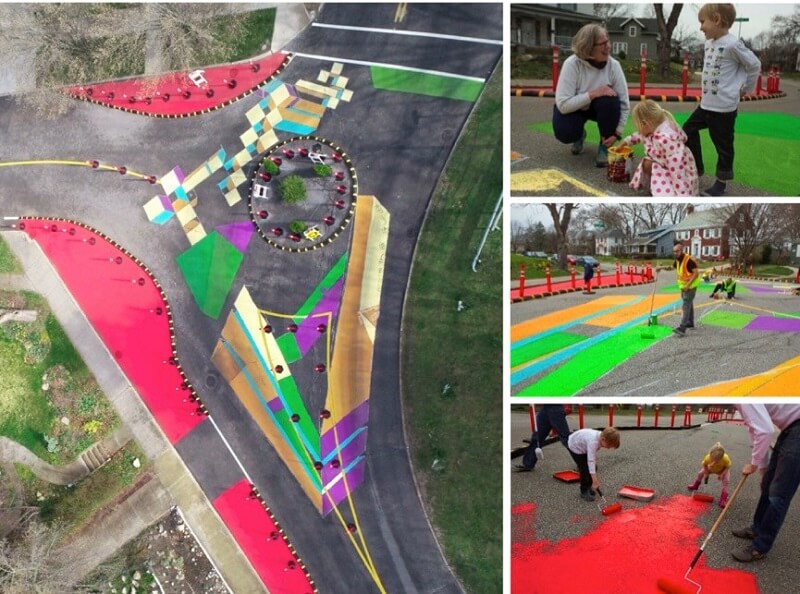 South Bend, IN
South Bend, IN
The biggest and hardest change is the shift to truly prioritize safety by changing safety culture on the roads. We cannot be complacent when it comes to losing so many people each and every day on our roads. We need leaders in this area, and I can think of none better than the members of this Committee and Subcommittee. The reauthorization is the vehicle to accomplish this change. We have changed safety culture in workplaces, around child passenger safety and in other areas. We can do it here too with your help.
Other Provisions
There are specific provisions in the FAST Act that can be improved to prioritize safety. These include:
- Altering the “Section 405” programmatic funds that largely go unused by reworking the program to give states different options
- Expanding the use of Highway Safety Improvement Program
Additionally, the National Safety Council believes we can use data to better target roadway areas for safety improvements. Identifying and prioritizing dangerous areas of roadways for safety improvements can save lives.
Several states have provided estimates to the U.S. Department of Transportation that the fatalities in their states will increase. Focusing the spending in those states on safety to prevent this projection from coming true should be a priority for Congress.
There are evidence-based safety solutions that federal dollars are prohibited to purchase or federal safety programs that have been cut, but there are several communities that would like to employ a range of options that will improve safety. Allowing flexibility in federal spending for evidence-based safety improvements can save lives, and I urge this committee to re-evaluate some of those restrictions on technology like automated enforcement and other programs.
NSC looks forward to working with this Committee to fully develop these provisions.
Conclusion
You have an opportunity in front of you to prioritize safety, and the National Safety Council is committed to working with you to reach zero fatalities on our roadways. I hope you will join me in saying enough is enough and start down the Road to Zero. It is not impossible. It just hasn’t been done yet.






